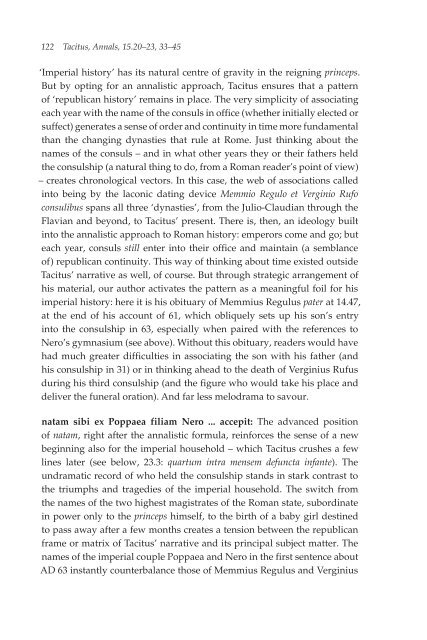Tacitus, Annals, 15.20-23, 33-45. Latin Text, Study Aids with Vocabulary, and Commentary, 2013a
Tacitus, Annals, 15.20-23, 33-45. Latin Text, Study Aids with Vocabulary, and Commentary, 2013a
Tacitus, Annals, 15.20-23, 33-45. Latin Text, Study Aids with Vocabulary, and Commentary, 2013a
You also want an ePaper? Increase the reach of your titles
YUMPU automatically turns print PDFs into web optimized ePapers that Google loves.
‘Imperial history’ has its natural centre of gravity in the reigning princeps.<br />
But by opting for an annalistic approach, <strong>Tacitus</strong> ensures that a pattern<br />
of ‘republican history’ remains in place. The very simplicity of associating<br />
each year <strong>with</strong> the name of the consuls in office (whether initially elected or<br />
suffect) generates a sense of order <strong>and</strong> continuity in time more fundamental<br />
than the changing dynasties that rule at Rome. Just thinking about the<br />
names of the consuls – <strong>and</strong> in what other years they or their fathers held<br />
the consulship (a natural thing to do, from a Roman reader’s point of view)<br />
– creates chronological vectors. In this case, the web of associations called<br />
into being by the laconic dating device Memmio Regulo et Verginio Rufo<br />
consulibus spans all three ‘dynasties’, from the Julio-Claudian through the<br />
Flavian <strong>and</strong> beyond, to <strong>Tacitus</strong>’ present. There is, then, an ideology built<br />
into the annalistic approach to Roman history: emperors come <strong>and</strong> go; but<br />
each year, consuls still enter into their office <strong>and</strong> maintain (a semblance<br />
of) republican continuity. This way of thinking about time existed outside<br />
<strong>Tacitus</strong>’ narrative as well, of course. But through strategic arrangement of<br />
his material, our author activates the pattern as a meaningful foil for his<br />
imperial history: here it is his obituary of Memmius Regulus pater at 14.47,<br />
at the end of his account of 61, which obliquely sets up his son’s entry<br />
into the consulship in 63, especially when paired <strong>with</strong> the references to<br />
Nero’s gymnasium (see above). Without this obituary, readers would have<br />
had much greater difficulties in associating the son <strong>with</strong> his father (<strong>and</strong><br />
his consulship in 31) or in thinking ahead to the death of Verginius Rufus<br />
during his third consulship (<strong>and</strong> the figure who would take his place <strong>and</strong><br />
deliver the funeral oration). And far less melodrama to savour.<br />
The advanced position<br />
of natam, right after the annalistic formula, reinforces the sense of a new<br />
beginning also for the imperial household – which <strong>Tacitus</strong> crushes a few<br />
lines later (see below, <strong>23</strong>.3: quartum intra mensem defuncta infante). The<br />
undramatic record of who held the consulship st<strong>and</strong>s in stark contrast to<br />
the triumphs <strong>and</strong> tragedies of the imperial household. The switch from<br />
the names of the two highest magistrates of the Roman state, subordinate<br />
in power only to the princeps himself, to the birth of a baby girl destined<br />
to pass away after a few months creates a tension between the republican<br />
frame or matrix of <strong>Tacitus</strong>’ narrative <strong>and</strong> its principal subject matter. The<br />
names of the imperial couple Poppaea <strong>and</strong> Nero in the first sentence about<br />
AD 63 instantly counterbalance those of Memmius Regulus <strong>and</strong> Verginius


















